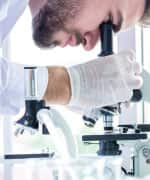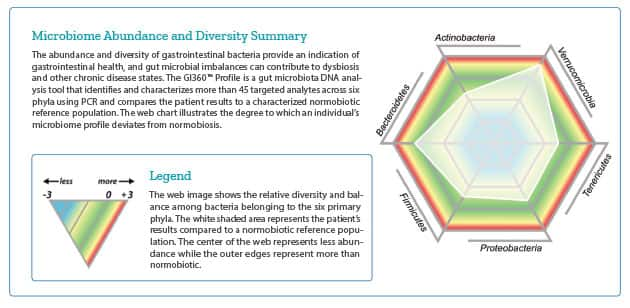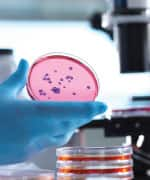Life Extension Magazine®
We’re hearing a great deal about the state of our gut microbiome and our exposure to toxic chemicals.
Life Extension® recently spoke with Dr. Shanti Albani and Dr. Scott Fogle about new tests that help us understand both—and about what steps can be taken to correct any problems.
Check Your Gut Health

Study after study has shown that the makeup of our gut microbiota—the bacteria and other microbes living in the large intestine—has tremendous influence on both gastrointestinal issues and overall health.
Life Extension® offers one of the most comprehensive gastrointestinal tests ever developed, which offers insight into a patient’s microbiome, and much more.
In this interview, Dr. Shanti Albani explains how it works and what it offers.
LE: What can you tell us about this new gastrointestinal (GI) test?
Dr. Albani: The GI360™ Profile is named for the 360-degree, detailed picture of gastrointestinal health it provides. The test looks at microbial balance, identifies pathogens, and includes multiple markers of gastrointestinal function, inflammation, and integrity. It provides more quality information than any test I have seen before.
LE: Is this test for people with intestinal issues or a wider range of individuals?
Dr. Albani: This test is for everyone. Hippocrates said, “All disease begins in the gut,” and now, more than 2,000 years later, research is proving that to be true. The bacteria in our intestines influence our mood, weight, and cardiovascular and liver health. Our gut microbiota shape how our immune system behaves in response to toxins, food, and pathogens, which influences our likelihood of an autoimmune disease or allergies. Our gut bacteria make chemicals, including neurotransmitters, which impact us for better or worse. I have seen cases where chronic brain fog only lifted after testing and favorably modulating the gut microbiota.
LE: What exactly does this test reveal?
Dr. Albani: One of the most fascinating components of the GI360™ Profile is the microbiome abundance and diversity testing. That tells you which major groupings of bacteria are occupying your intestines. It includes both a high-level view of the balance between the six main groups, or phyla, of bacteria, and detailed identification of individual species of bacteria. Profiling the phyla tells you if your bacterial pattern matches those of healthy people or is more reflective of the unbalanced bacterial patterns associated with intestinal symptoms, obesity, or other health concerns.
LE: What makes this test different from others on the market?

Dr. Albani: For one, it’s extremely accurate. The test uses sophisticated DNA probes to identify intestinal microbes according to their DNA fingerprint. This bacterial profiling has been used in over 20 clinical trials and has been clinically verified to separate individuals with an imbalanced, or dysbiotic, gut flora from those with a healthy one.
Also, other gut microbiota tests will often just provide a list of bacteria
without any context, leaving the person baffled about what the information
means. The GI360™ Profile results include information on the health impact
of microbial imbalances and potential actions to
shift the gut microbiota toward a more balanced state.
LE: Does the test look for pathogenic bacteria as well?
Dr. Albani: Of course. The next section of the test focuses on GI pathogens. It uses microbial DNA probes to detect 14 pathogens, including villains like rotavirus, Salmonella, Shigella, Clostridium difficile, and Giardia. Anyone with acute intestinal symptoms or ongoing intestinal distress should be looking to rule these problem-causers out.
LE: Can it detect parasites?
Dr. Albani: Yes. The GI360™ Profile includes a microscopic stool examination. This examines the stool for parasite larva, eggs, or adults. The highly experienced lab techs who perform these tests can detect protozoa, tapeworms, flukes, roundworms, and yeast by looking at the stool under the microscope. You would be surprised how many people have unwelcome travelers in their intestines!
LE: Yeast like Candida can cause fungal infections. Does the GI360™ Profile screen for that?
Dr. Albani: It does. The test includes a bacterial and yeast culture, which is the gold standard for detecting intestinal bacterial and yeast overgrowth. The lab we partner with uses advanced culture techniques, with 10 different growing conditions instead of the three used by most labs, along with a yeast culture able to detect over 170 species of yeast and 80 species of Candida. Candida and yeast overgrowth is a common concern associated with bloating, fatigue, and brain fog.
The culture also features a sensitivity section. That means if an unwanted microbe is identified, the lab provides information about its sensitivity to various antibiotics and to natural agents. That gives individuals and their healthcare providers treatment flexibility and greater confidence that a treatment will be effective.

LE: Does the test measure anything else?
Dr. Albani: The last section of the GI360™ Profile is stool chemistries. This looks at a broad range of markers to evaluate digestive capacity, intestinal immune function, and intestinal inflammation. Our digestive system should efficiently extract nutrients and calories from the food we eat. Stool that tests positive for carbohydrates, fat, or too many muscle and vegetable fibers can indicate a lack of digestive power. In addition, stool should have adequate amounts of the pancreatic enzyme elastase. If elastase is low, it can indicate that your pancreas is not producing adequate enzymes to optimally digest food.
Inflammation is a driver of chronic disease and aging. The GI360™ Profile includes three markers of intestinal inflammation— and one marker of intestinal immune function, secretory immunoglobulin A (sIgA). The inflammatory markers can both identify inflammation and help distinguish its cause. For example, an elevation in all three intestinal inflammation markers would be expected in ulcerative colitis and Crohn’s disease, but if only lysozyme is elevated, it is more indicative of an intestinal infection.
LE: That sounds incredibly thorough. Is there anything else the stool chemistries section reveals?
Dr. Albani: It shows levels of a unique marker called b-glucuronidase. High levels of b-glucuronidase may be associated with an imbalanced intestinal microbiota, as well as higher circulating estrogen in premenopausal women and potentially less efficient toxin elimination. Given that we now live in a world saturated with pollutants, this marker can help us determine if our gut microbiota is working well enough when it comes to detoxification.
LE: What steps can someone take if the GI360™ Profile raises concerns?
Dr. Albani: Anything marked as abnormal is commented on at the end of the results report so individuals are not left in the dark about its meaning. Anyone who has done the test can call to review the results with one of the highly trained Life Extension® Wellness Specialists at no additional cost. They can provide a wellness plan that can be discussed with your healthcare provider to assist in making the best decisions related to your results.
Measure Toxic Chemical Levels

As Dr. Albani notes, our gut microbiota can help us cope with pollutants, but only to a degree. It’s vital to ensure that levels of toxins in our body aren’t too high.
Life Extension® is also offering a new urine test that can measure levels of toxic chemicals in the body.
In this interview, Dr. Scott Fogle discusses what this test can tell us and how we can help our bodies detox.
LE: What does this new test screen for?
Dr. Fogle: Last year, we introduced our Toxic Metals Panel Fecal Test, stool testing to look at levels of some of the worst metal toxins like mercury. This year, we are introducing the Environmental Pollutants Profile, a urine test to look at some of the most problematic chemicals like toluene, benzene, xylene, and parabens.
LE: Why is one a stool test and the other a urine test?
Dr. Fogle: It relates to how the body processes, or detoxifies, the different toxins we are exposed to. Heavy metals are naturally detoxified via the liver and then excreted in the stool. Chemical toxins are more often excreted in urine.
LE: How are people exposed to these chemicals in the first place?
Dr. Fogle: They are ubiquitous in the environment nowadays. Here are the most common sources of these toxins:
- Xylene: an additive in gasoline which is also used to produce solvents, fragrances, coatings, and paints.
- Toluene: an additive used in nylon and plastics that is also found in gasoline, coatings, paints, synthetic fragrance, adhesives, inks, and cleaners.
- Trimethylbenzene: a petroleum-based additive that may be found in gasoline, paints, and cleaners, and also in contaminated groundwater.
- Styrene: an additive used in plastics, fiberglass, rubber, and latex found in insulation, packing materials, printer ink and toner cartridges, household objects, car exhaust, and cigarette smoke.
- Phthalates: plastic additives used in vinyl flooring, raincoats, nail polish, and body-care products.
- Parabens: preservatives used in cosmetics, body products, foods, and medications.
- Methyl tert-butyl ether (MTBE): a gasoline additive inhaled from gasoline or car exhaust fumes.
LE: Who is at risk from these chemical toxins?
Dr. Fogle: All of us. Even healthy people will become sick if exposed to excessively high amounts of these chemicals. We are, in a sense, filters and air purifiers for the environment around us. We accumulate toxins, and there is a theory that once the body is saturated with chemicals beyond its ability to cope or detoxify them, the toxins start affecting our health. Everyone can benefit from getting their toxin levels checked.

The most susceptible people are those who have inherited low-activity forms of detoxification enzymes, those with poor nutrition or poor nutrient absorption due to gastrointestinal issues, or those suffering from existing chronic inflammatory or autoimmune conditions. It may be especially important for these people to monitor and reduce their exposures to toxic chemicals.
LE: What can people do if they have high toxin levels?
Dr. Fogle: There are many approaches that can help with detox. Exercise is often vital. Sweating can help—but make sure to shower right after or you can start absorbing the toxins right back in through the skin. Infrared saunas also helpful. Consume 2-3 liters of clean water daily. It is also important to consume fresh, organic fruit and veggies. They contain nutrients that support our liver’s ability to detox.
LE: Are there nutrients people can take directly that also support detoxification?
Dr. Fogle: Yes. My all-time favorite is glutathione. I think of it as a bodyguard that grabs a toxin, binds to it, and escorts it out of the body. Lipoic acid is another of my top choices, because it can function as an antioxidant in both a water and fat environment, which means it can work in every cell. The amino acid glycine is also needed for detox, as are the minerals magnesium and selenium and vitamins E and C. Sulforaphane, which is found in broccoli sprouts, also activates detoxification enzymes.
LE: Does gastrointestinal health play a role in healthy detox?
Dr. Fogle: Yes, it is critical for good detoxification. The longer stools stay inside you, the more chance you have of reabsorbing some of the toxins your body works so hard to get rid of. It is best to have two or three bowel movements a day if actively detoxing. Probiotics can be essential to help with this.
If you have any questions on the scientific content of this article, please call a Life Extension® Wellness Specialist at 1-866-864-3027.
Dr. Shanti Albani earned her medical degree in Naturopathic Medicine in 2003 from the National University of Natural Medicine in Portland, Oregon. She practiced medicine for many years in central Mexico specializing in gastrointestinal disorders and hormone balance. During this time she taught courses for physicians in bioidentical hormone replacement therapy. She has worked at Life Extension® since 2010 and is currently the Manager of Clinical Information.
Dr. Scott Fogle is the Executive Director of Clinical Information and Laboratory Services at Life Extension®, where he oversees scientific and medical information as well as its laboratory division.

